Imagine transforming your home with bursts of sunny yellow blooms that thrive with minimal effort! The yellow kalanchoe plant, a stunning succulent, is the perfect choice for beginners and seasoned plant lovers alike. Known for its vibrant flowers and easy-care nature, this plant brings joy to any space. Whether you’re new to plant care or looking to master the art of growing a yellow kalanchoe plant, this guide is your roadmap to success. 🌞 We’ll cover everything from light and watering to propagation and troubleshooting, ensuring your kalanchoe flourishes for years. Let’s dive in and unlock the secrets to vibrant blooms!
1. Understanding the Yellow Kalanchoe Plant 🌿
1.1 What Is a Yellow Kalanchoe?
The yellow kalanchoe (Kalanchoe blossfeldiana) is a succulent native to Madagascar, celebrated for its clusters of bright yellow flowers and thick, glossy leaves. Typically growing to 12–18 inches tall, it’s compact enough for indoor pots or outdoor gardens. Its cheerful blooms and drought-tolerant nature make it a favorite among plant enthusiasts. Unlike other houseplants, the yellow kalanchoe requires minimal fuss, making it ideal for those seeking low-maintenance greenery.
1.2 Benefits of Growing a Yellow Kalanchoe
Why choose a yellow kalanchoe? Beyond its eye-catching flowers, this plant offers multiple benefits:
- Aesthetic Appeal: Its vibrant yellow blooms add a pop of color to any room, patio, or garden.
- Air Purification: Studies, like those from NASA, show succulents can improve indoor air quality by removing toxins.
- Emotional Boost: The bright flowers can uplift your mood, reducing stress and enhancing well-being, according to research on biophilic design.
- Versatility: Perfect for small spaces, offices, or as a gift for plant-loving friends.
1.3 Common Varieties of Yellow Kalanchoe
Several yellow kalanchoe cultivars stand out:
- ‘Yellow Calandiva’: Known for double-petaled flowers, resembling mini roses.
- ‘Goldstrike’: Features larger blooms and slightly variegated leaves.
- ‘Lemon Drop’: Compact with delicate, pale yellow flowers.
Each variety has unique traits, but all thrive under similar care conditions. Expert Tip: Choose a cultivar based on your climate—‘Goldstrike’ is more heat-tolerant, while ‘Calandiva’ excels indoors.
2. Essential Care Requirements for a Healthy Yellow Kalanchoe 🌱
2.1 Light Needs ☀️
Light is the cornerstone of yellow kalanchoe care. These plants crave bright, indirect sunlight for 6–8 hours daily. Indoors, place them near south- or west-facing windows. Outdoors, a shaded patio or spot with filtered sunlight works best. Direct sun can scorch leaves, causing brown, crispy edges. If natural light is limited, consider a grow light (e.g., a 6500K full-spectrum LED). Expert Insight: Use sheer curtains to diffuse harsh sunlight indoors, preventing leaf burn while ensuring adequate brightness.
2.2 Watering Guidelines 💧
As a succulent, the yellow kalanchoe stores water in its leaves, making it drought-tolerant. Water sparingly, allowing the soil to dry out completely between waterings—typically every 10–14 days. Overwatering is the leading cause of kalanchoe failure, leading to yellowing leaves or mushy stems. Use a pot with drainage holes and check soil moisture with your finger or a moisture meter. Pro Tip: In winter, reduce watering to once every 3–4 weeks, as the plant enters dormancy.
2.3 Soil and Potting Mix 🌍
Yellow kalanchoes thrive in well-draining soil. A cactus or succulent potting mix is ideal, but you can create your own by combining:
- 50% potting soil
- 30% perlite
- 20% coarse sand
This mix ensures proper drainage and prevents root rot. Repot every 1–2 years or when the plant outgrows its container. Choose a pot slightly larger than the root ball to avoid excess moisture retention.
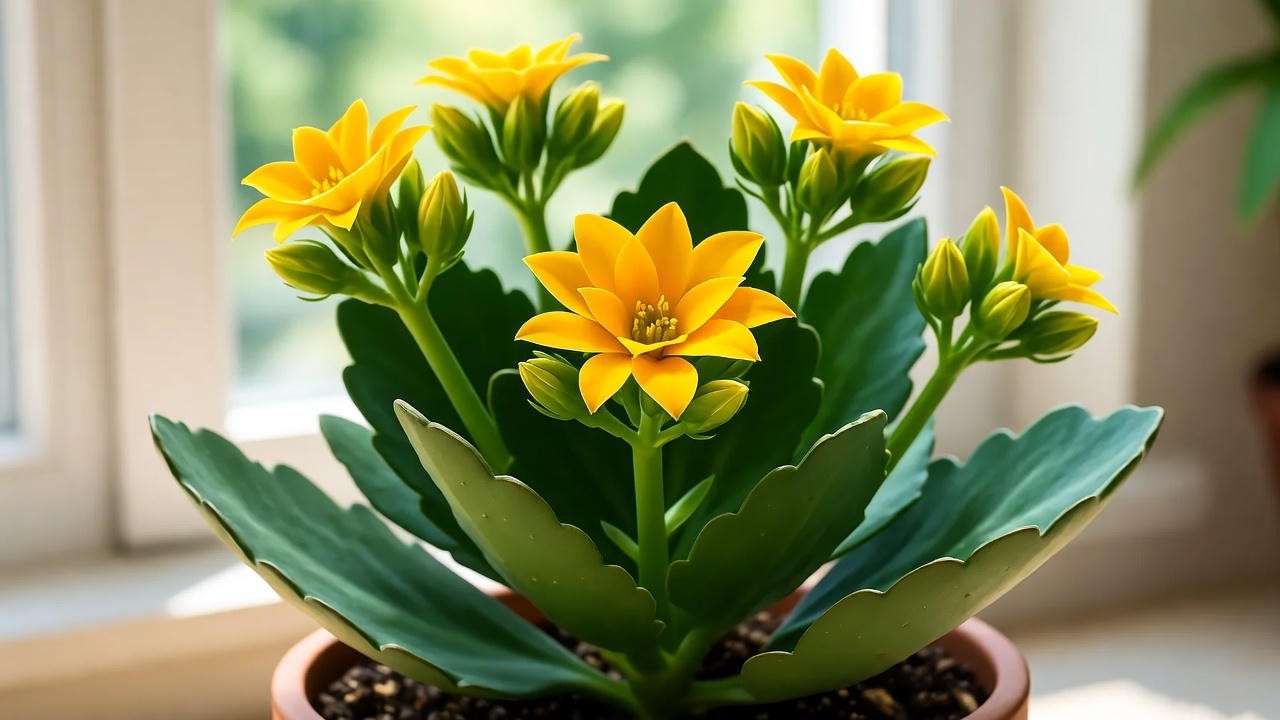
2.4 Temperature and Humidity 🌡️
Yellow kalanchoes prefer temperatures between 60–85°F (15–29°C). They tolerate low to moderate humidity, making them adaptable to most indoor environments. Avoid exposing them to temperatures below 50°F (10°C), as cold drafts can cause leaf drop. In winter, keep them away from windowsills or heaters. Expert Tip: If you live in a humid climate, ensure good air circulation to prevent fungal issues.
2.5 Fertilizing for Optimal Growth 🌸
Fertilize sparingly to encourage healthy growth and vibrant blooms. Use a balanced, water-soluble fertilizer (e.g., 10-10-10) diluted to half strength. Apply monthly during the growing season (spring and summer). Avoid fertilizing in fall and winter, as the plant rests. Over-fertilizing can cause leggy growth or root burn. Warning: Always water the plant before fertilizing to protect the roots.
3. How to Encourage Vibrant Yellow Blooms 🌻
3.1 Understanding Bloom Cycles
Yellow kalanchoes typically bloom from late winter to early spring, producing clusters of star-shaped flowers. To encourage reblooming, mimic their natural short-day conditions: 14 hours of darkness daily for 6–8 weeks. Place the plant in a dark closet or cover it with a box each night. This triggers flower bud formation. Example: Start this process in late fall to enjoy blooms by early spring.
3.2 Pruning and Deadheading ✂️
Pruning keeps your kalanchoe compact and encourages new blooms. Deadhead spent flowers by pinching them off with clean fingers or scissors to redirect energy to new growth. To prune leggy stems:
- Use sterilized, sharp scissors.
- Cut just above a leaf node, removing up to one-third of the stem.
- Allow cuttings to callus for propagation (see Section 5).
Pro Tip: Regular pruning promotes a bushier, healthier plant.
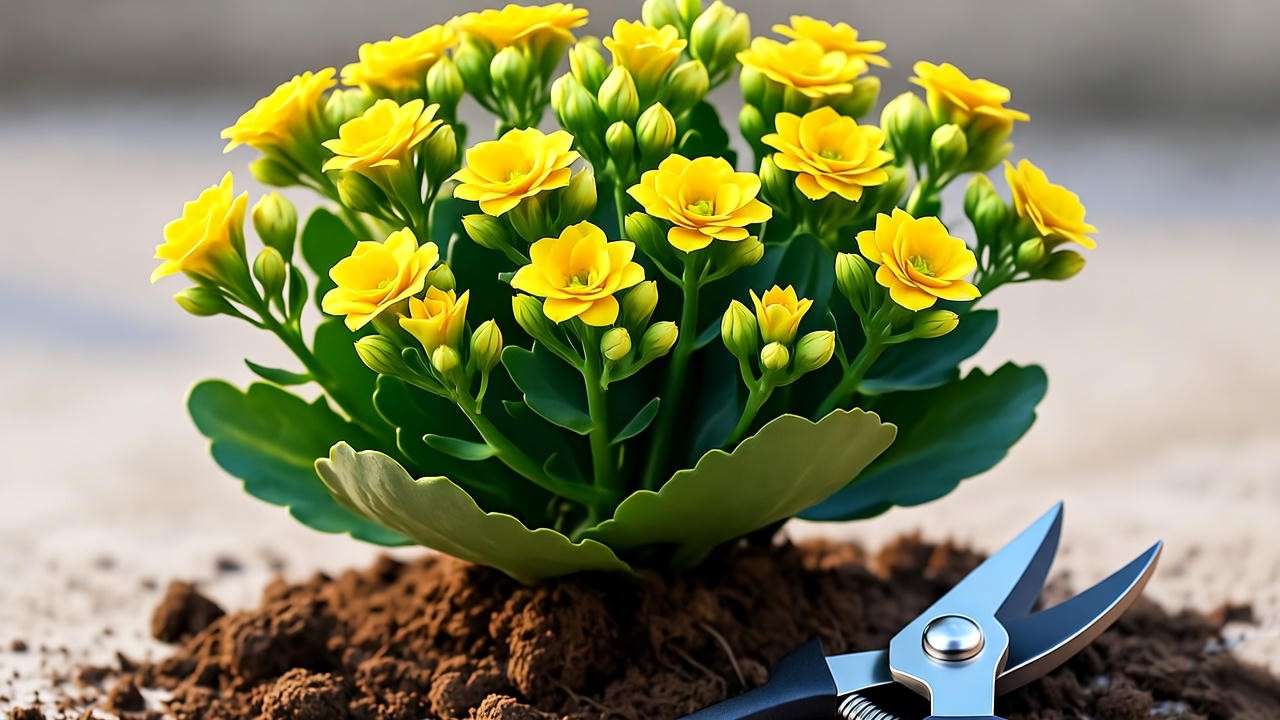
3.3 Common Blooming Issues and Solutions
If your kalanchoe isn’t blooming, check these factors:
- Insufficient Light: Move to a brighter location or supplement with a grow light.
- Incorrect Day Length: Ensure consistent dark periods for 6–8 weeks.
- Nutrient Imbalance: Avoid over-fertilizing, which can prioritize foliage over flowers.
Expert Insight: Patience is key—blooming may take time, especially for young plants.
4. Common Problems and How to Solve Them 🛠️
4.1 Pests and Diseases 🐞
Yellow kalanchoes are relatively pest-resistant but can attract mealybugs, aphids, or spider mites. Inspect leaves regularly, especially undersides. Treat early infestations with neem oil or insecticidal soap. Root rot (from overwatering) and powdery mildew (from high humidity) are common diseases. Prevent root rot by using well-draining soil and watering sparingly. For mildew, improve air circulation and apply a fungicide if needed. Expert Tip: Isolate affected plants to prevent pest spread.
4.2 Yellowing Leaves or Drooping
Yellowing or drooping leaves signal care issues:
- Overwatering: Check soil moisture; reduce watering frequency.
- Underwatering: Water thoroughly if soil is bone-dry.
- Poor Light: Relocate to a brighter spot.
Use this troubleshooting checklist:
- Test soil moisture.
- Assess light exposure.
- Inspect for pests or disease.
Pro Tip: Keep a care journal to track watering and light conditions for consistent care.
4.3 Leggy Growth
Leggy growth occurs when the plant stretches toward light due to insufficient brightness. Move it to a spot with more indirect sunlight and prune back elongated stems. Regular rotation prevents uneven growth. Solution: A grow light can supplement natural light in low-light environments.
5. Propagating Your Yellow Kalanchoe 🌱
5.1 Why Propagate?
Propagating your yellow kalanchoe is a rewarding way to expand your plant collection or share with friends and family. It’s cost-effective, sustainable, and allows you to create new plants from a single healthy specimen. Plus, propagation is a fun way to deepen your connection with your plants and understand their growth habits. Whether you’re a beginner or an experienced gardener, propagating kalanchoes is straightforward and highly successful due to their succulent nature.
5.2 Propagation Methods
Yellow kalanchoes can be propagated through three main methods: leaf cuttings, stem cuttings, and offsets. Here’s how to do each:
- Leaf Cuttings
- Select a healthy, plump leaf from the parent plant.
- Gently twist or cut the leaf, ensuring a clean break.
- Let the leaf callus over for 1–2 days in a dry, shaded area to prevent rot.
- Place the leaf on a well-draining succulent mix or in a shallow dish of water, ensuring the cut end touches the medium.
- Mist lightly every few days and keep in bright, indirect light. Roots and tiny plantlets should appear in 2–4 weeks.
Expert Tip: Be patient—leaf cuttings take longer than other methods but are highly reliable.
- Stem Cuttings
- Choose a healthy, non-flowering stem (4–6 inches long) and cut just below a leaf node with sterilized scissors.
- Allow the cutting to callus for 1–2 days.
- Plant the cutting in a small pot filled with cactus or succulent mix, burying the cut end about 1 inch deep.
- Water sparingly and place in bright, indirect light. Roots typically form within 2–3 weeks.
Pro Tip: Dip the cut end in rooting hormone (optional) to speed up root development.
- Offsets
- Look for small plantlets (pups) growing at the base of the mother plant.
- Gently separate the offset using a clean knife or your fingers, ensuring some roots are attached.
- Plant the offset in a small pot with well-draining soil.
- Water lightly and treat as a mature plant, providing bright, indirect light.
Expert Insight: Offsets are the fastest way to propagate, as they’re essentially mini plants ready to grow.
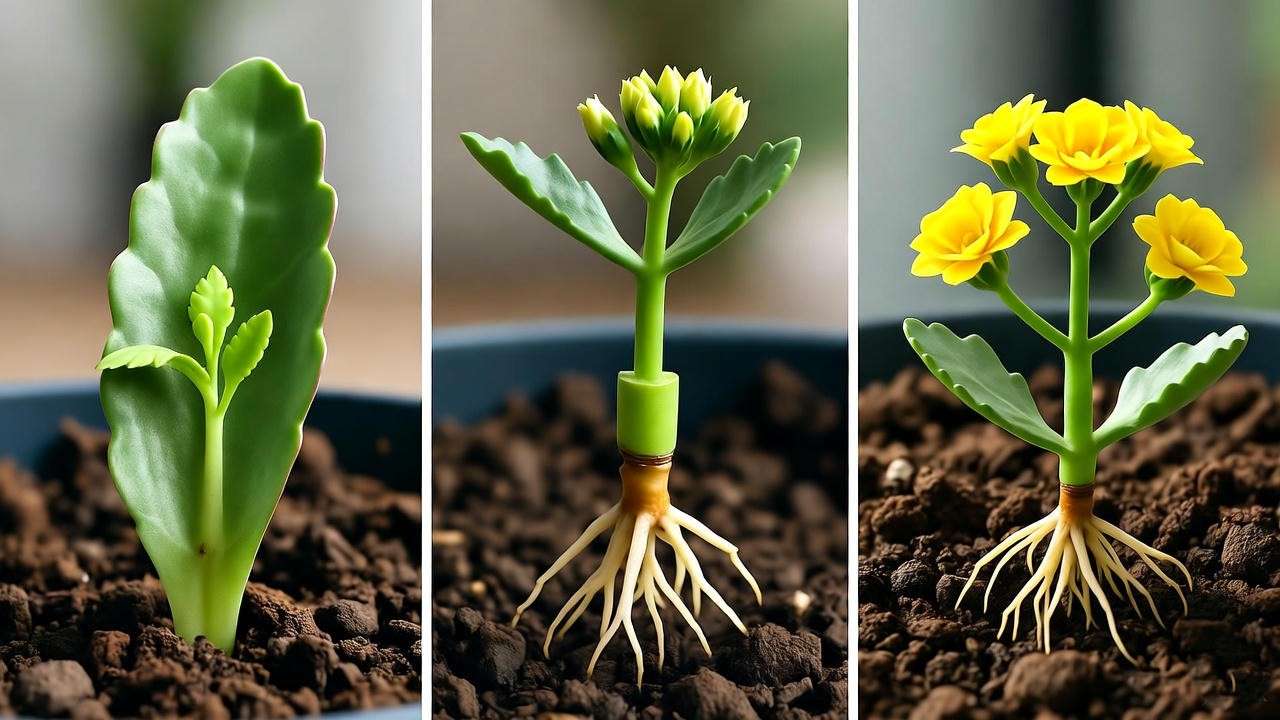
5.3 Caring for New Plants
Newly propagated kalanchoes need gentle care to establish strong roots. Water sparingly, ensuring the soil stays slightly moist but not soggy. Place in bright, indirect light and avoid direct sun to prevent stress. Expect roots to form within 2–4 weeks and new growth in 6–8 weeks. Once established, transition to regular kalanchoe care (see Section 2). Pro Tip: Use small pots initially to encourage root development without excess soil moisture.
6. Decorating with Yellow Kalanchoes 🏡
6.1 Indoor Display Ideas
Yellow kalanchoes are versatile for indoor decor, adding a cheerful touch to any space. Here are some creative ideas:
- Colorful Pots: Plant in vibrant ceramic or terracotta pots to complement the yellow blooms.
- Terrariums: Combine with other succulents in a glass terrarium for a modern look.
- Windowsills and Desks: Their compact size makes them perfect for small spaces like coffee tables, bookshelves, or office desks.
- Companion Plants: Pair with low-maintenance succulents like echeveria, haworthia, or aloe for a stunning display.
Expert Tip: Group multiple kalanchoes in varying shades (yellow, pink, red) for a vibrant, cohesive arrangement.
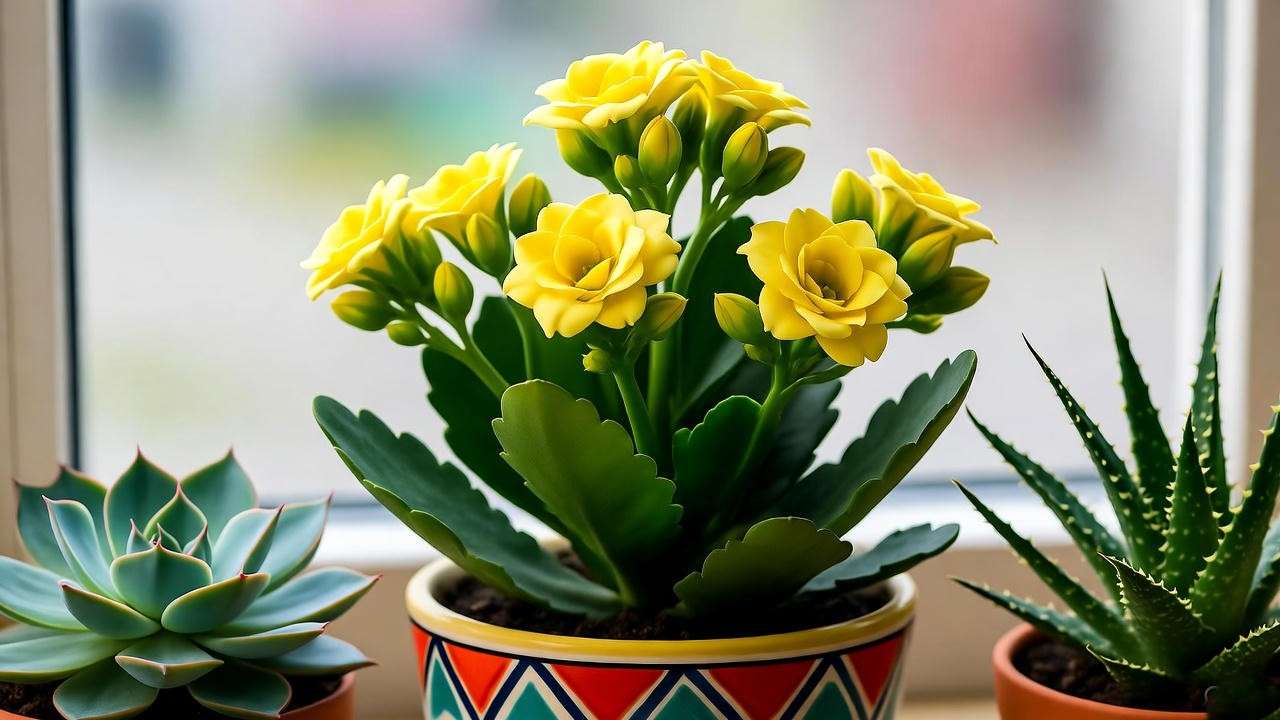
6.2 Outdoor Uses
In warm climates (USDA zones 10–12), yellow kalanchoes thrive outdoors. Use them in:
- Rock Gardens: Their drought tolerance makes them ideal for xeriscaping alongside cacti or agave.
- Container Gardens: Create mixed succulent arrangements in large pots or troughs.
- Borders: Plant along garden edges for pops of color.
In colder climates, bring potted kalanchoes indoors during winter to protect from frost. Pro Tip: Use a frost blanket or move pots to a sheltered patio if temperatures dip below 50°F (10°C).
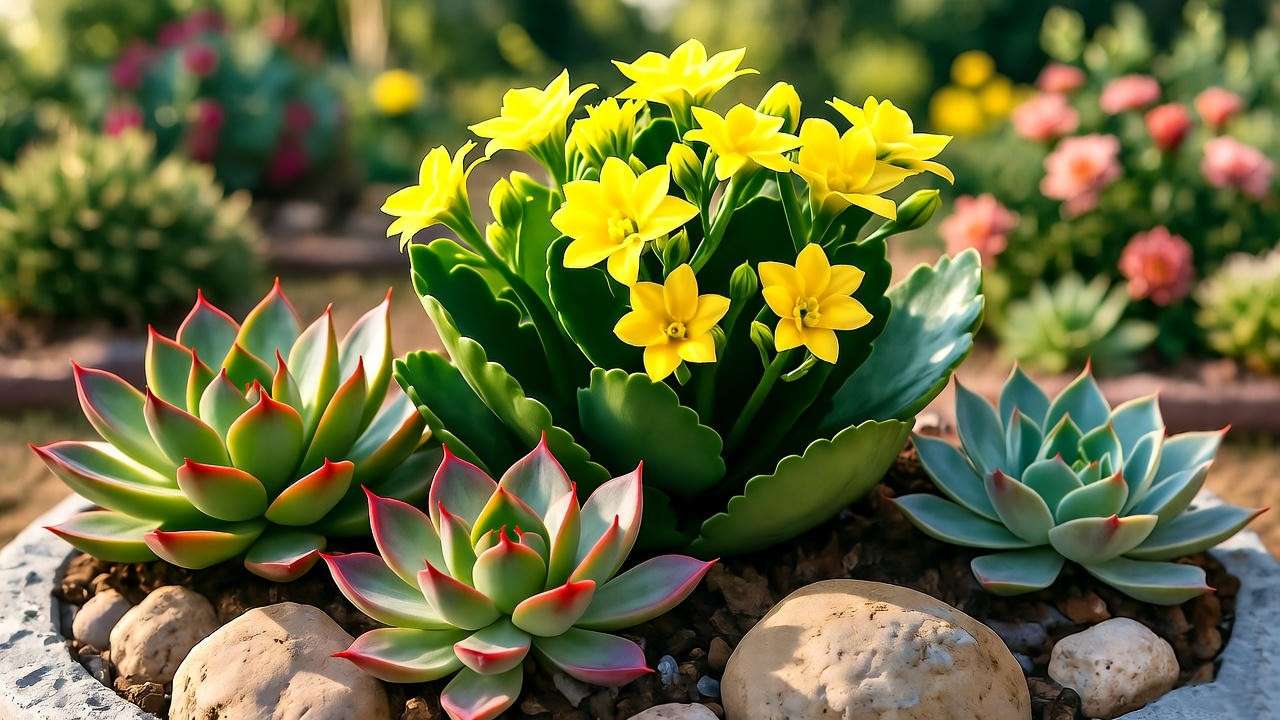
6.3 Seasonal Decor
Yellow kalanchoes shine in seasonal displays:
- Spring and Summer: Place in outdoor containers or hanging baskets for vibrant patio decor.
- Holidays: Incorporate into Easter arrangements with pastel-colored pots or Mother’s Day gifts paired with a heartfelt note.
- Year-Round: Their long-lasting blooms make them a staple for any season.
Expert Insight: Refresh displays by deadheading spent blooms and rotating pots for even growth.
7. Expert Tips for Long-Term Success 🌟
To ensure your yellow kalanchoe thrives for years, follow these expert tips:
- Rotate Regularly: Turn the plant every 1–2 weeks to promote even growth and prevent leaning toward light.
- Monitor Seasons: Adjust watering and light exposure in fall and winter when growth slows.
- Use Grow Lights: In low-light homes, invest in a full-spectrum LED grow light (e.g., Sansi 15W or GE BR30). Position 12–18 inches above the plant for 8–10 hours daily.
- Maintain a Schedule: Consistency is key. Use a calendar or app to track watering, fertilizing, and pruning.
- Check Drainage: Always ensure pots have drainage holes and avoid saucers that trap water.
Expert Insight: Treat your kalanchoe like a friend—observe its needs, respond to changes, and it’ll reward you with vibrant growth.
8. Frequently Asked Questions (FAQs) ❓
- How often should I water my yellow kalanchoe?
Water every 10–14 days, ensuring the soil dries out completely. In winter, reduce to every 3–4 weeks. - Why isn’t my kalanchoe blooming?
Lack of blooms is often due to insufficient light or incorrect day length. Provide 6–8 hours of bright, indirect light and 14 hours of darkness for 6–8 weeks to trigger flowering. - Can yellow kalanchoes grow outdoors year-round?
Yes, in USDA zones 10–12. In colder regions, bring indoors during winter to protect from frost. - Are yellow kalanchoes toxic to pets?
Yes, they are toxic to cats and dogs if ingested, causing vomiting or lethargy. Keep out of reach and consult a vet if ingestion occurs. - How long do yellow kalanchoe blooms last?
Blooms can last 6–8 weeks with proper care. Deadheading extends the blooming period.
9. Conclusion
The yellow kalanchoe plant is a delightful addition to any home or garden, offering vibrant blooms and easy-care charm. By providing bright, indirect light, watering sparingly, and following our expert tips on pruning, fertilizing, and propagation, you can enjoy a thriving plant year after year. Whether you’re decorating your living room, gifting a friend, or experimenting with propagation, this succulent is a rewarding choice for beginners and experts alike. 🌻 Start growing your yellow kalanchoe today and share your success stories in the comments below! For more plant care inspiration, explore our guides on succulent care, indoor gardening, and more.













